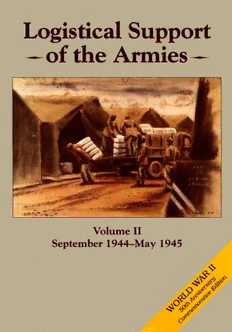Table Of ContentUNITED STATES ARMY IN WORLD WAR II
The European Theater of Operations
LOGISTICAL SUPPORT
OF THE ARMIES
In Two Volumes
Volume II: September 1944-May 1945
by
Roland G. Ruppenthal
CENTER OF MILITARY HISTORY
UNITEDS TATES ARMY
WASHINGTON,D .C., 1995
Library of Congress Catalog Number: 53–60080
FirstP rinted 1959—CMH Pub 7–3–1
For sale by the US. Government Printing Office
Superintendent of Documents, Mail Stop: SSOP, Washington, D.C. 20402
UNITED STATES ARMY IN WORLD WAR II
Kent Roberts Greenfield, General Editor
Advisory Committee
(As of 30 May 1958)
Elmer Ellis Brig. Gen. John B. Sullivan
University of Missouri U.S. Continental Army Command
Samuel Flagg Bemis Brig. Gen. Edgar C. Doleman
Yale University Army War College
Gordon A. Craig Brig. Gen. Frederick R. Zierath
Princeton University Command and General Staff College
Oron J. Hale Brig. Gen. Kenneth F. Zitzman
University of Virginia Industrial College of the Armed Forces
W. Stull Holt Col. Vincent J. Esposito
University of Washington United States Military Academy
T. .Harry Williams
Louisiana State University
Office of the Chief of Military History
Maj. Gen. Richard W. Stephens, Chief
Chief Historian Kent Roberts Greenfield
Chief, Histories Division Col. Seneca W. Foote
Chief, Editorial and Publication Division Lt. Col. E. E. Steck
Editor in Chief Joseph R. Friedman
Chief, Cartographic Branch Elliot Dunay
Chief, Photographic Branch Margaret E. Tackley
iii
to Those Who Served
. . .
Foreword
This volume completes the bridge between combat and services in the
European theater for which the author laid the foundations in Volume I.
It is as important a book for combat commanders as for those who have to
plan and execute logistical operations. It will leave the nonmilitary reader
in no doubt of the enormous weight and complexity of the administrative
burden that the Army had to assume to assure the success of its ground and
air forces, and the resourcefulness with which it managed that burden.
On the other hand, those who have to think about the future can here
study a test of the principle of a single service of supply supporting the
national element of allied forces under a coalition headquarters and a
supreme allied commander.
R. W. STEPHENS
Washington, D.C. Maj. Gen., U.S.A.
15J une 1958 Chief of Military History
vii
Preface
This volume completes the story of the logistic support of U.S. forces
in the European theater, carrying the account forward from mid-September
1944 to the end of hostilities in May 1945. It follows the pattern, established
in Logistical Support of the Armies, Volume I, of focusing on the influence
which logistical support or lack of it had on the planning and the conduct
of tactical operations. The inclination consequently has been to concen-
trate on the problem areas in logistic support, such as port discharge and
transportation difficulties, and supply and manpower shortages. As explained
in the Preface to Volume I, it was not intended to cover all aspects of
logistics as the term is commonly defined. To avoid duplication, such sub-
jects as hospitalization and evacuation, communications, and construction
are purposely left to the technical service histories, where they can be given
proper coverage. The one major exception is the account of the rebuilding
of Cherbourg, which was so important to the development of the logistic
structure in the summer and early fall of 1944 that it is presented as a case
history in planning and execution. A substantial amount of space has been
given to the discussion of theater command and organization because of
the persistent influence which that problem had on logistic support and on
the relations between the service and combat elements. In general, the
topical treatment predominates, but within the boundaries of the two dis-
tinct periods of tactical developments. One major violation of chronology
occurs in the treatment of local procurement (Chapter XVIII), which did
not lend itself to division.
The author’s work was again lightened by the use of preliminary studies
prepared by members of the Historical Section, ETO. For Volume II these
were: Robert W. Coakley’s two-volume study of theater command and
organization; John E. Henderson’s study of the replacement problem; and
George H. Elliott’s study of the use of indigenous manpower. Once again
Mr. Royce L. Thompson gave invaluable aid in running down records and
in researching several thorny problems.
It is a pleasure to acknowledge the help of the several persons who con-
tributed so cordially and generously in the final production of the volume:
Mr. Joseph R. Friedman and Miss Ruth Stout for their expert editorial
judgment; Mrs. Loretto Stevens for the laborious work of copy editing the
manuscript; Mr. Wsevolod Aglaimoff for the excellent cartographic work;
ix

